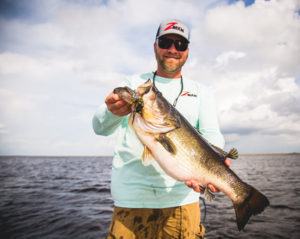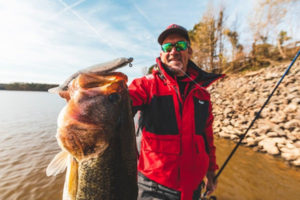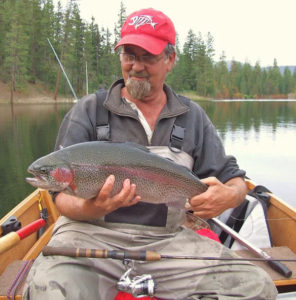ICAST Announces 29 Fishing Tackle Retailer New Product Showcase Winners Plus “Best of Show”
from The Fishing Wire
One of the most popular featured events at ICAST, the New Product Showcase, sponsored by Fishing Tackle Retailer/Decode, is a once-a-year opportunity to see the latest and greatest innovations all in one place.
Orlando, FL – Wednesday night, the ICAST 2019 “Best of Category” winners were announced during the awards reception. One of those 29 category winners on Thursday was named “Best of Show”. This year’s winner:
The “Best of Category” awards were presented during the Wednesday night New Product Showcase Awards Reception, sponsored by SiOnyx. Winners were selected by credentialed buyers and media from around the world who vote for the best of the new product entries. The “Best of Show” overall category was awarded Thursday afternoon. This year’s winner: Garmin, and its Force™ Trolling Motor.
One of the most popular featured events at ICAST, the New Product Showcase, sponsored by Fishing Tackle Retailer/Decode, is a once-a-year opportunity to see the latest and greatest innovations all in one place.
After launching July 9, with Super Tuesday, ICAST, the premier annual event for the global recreational fishing industry, is in full swing through Friday, July 13. ICAST is produced by the American Sportfishing Association (ASA). ASA is a national, non-profit trade association made up of more than 800 members who share a stake in promoting sportfishing for the well-being of our businesses and as part of our national heritage.
For ICAST 2019, 1,004 new products were entered by 303 companies. Reflecting trends in sportfishing retail, four new categories were added this year: Ice Fishing; Technical Apparel – Warm Weather, Technical Apparel – Cold Weather; Coolers and Bait/Storage; and Cutlery, Hand Pliers or Tools.
“We congratulate last night’s winners for contributing their ideas and hard work to the innovative spirit that keeps our industry growing,” said Blake Swango, ASA’s vice president for Trade Show and Membership. “We’re pleased that ICAST once again serves as a showcase for the best in sportfishing and the entire outdoor, on-the-water experience.”
All New Product Showcase entries are available for viewing on the ICAST website and on the ICAST app for Apple and Android devices.
ICAST 2019 New Product Showcase Best of Category Award Winners
For product details, images and other information please contact the individual award winners’ contacts listed below.
Best of Category – Boating Accessories – Garmin USA
Product: Force™ Trolling Motor
Contact: Carly Hysell
Best of Category – Boats and Watercraft – Hobie
Product: Mirage ProAngler 14 with 360 Drive Technology
Contact: Sean Douglas
Best of Category – Eyewear – Costa Del Mar, Inc.
Product: WaterWoman
Contact: Heather Miller
Best of Category – Footwear – Frogg Toggs
Product: Skipper
Contact: Missy Thompson
Best of Category – Giftware – 13 Fishing
Product: Fillet Table Beverage Management System
Contact: Stacie Lowe
Best of Category – Lifestyle Apparel – AFTCO/American Fishing Tackle Company
Product: Yurei Air-O-Mesh Performance Shirt
Contact: Denny Le
Best of Category – Technical Apparel – Cold Weather – Simms Fishing Products
Product: M’s G4Z® Stockingfoot Wader
Contact: John Frazier
Best of Category – Technical Apparel – Warm Weather – AFTCO/American Fishing Tackle Company
Product: Overboard Submersible Shorts
Contact: Denny Le
Best of Category – Ice Fishing – Johnson Outdoors Marine Electronics, Inc.
Product: Ice Helix 7 Chirp GPS G3N All-Season
Contact: Sandra Galis
Best of Category – Cooler and Bait/Storage – Plano Synergy
Product: Frabill Magnum Bait Station 30
Contact: Angelica Vazquez
Best of Category – Cutlery, Hand Pliers or Tools – Bubba
Product: 110V Electric Fillet Knife
Contact: Logan Waddell
Best of Category – Electronics – Johnson Outdoors Marine Electronics, Inc.
Product: MEGA 360 Imaging
Contact: Sandra Galis
Best of Category – Fly Fishing Accessory – Simms Fishing Products
Product: Dry Creek® Z Sling Pack
Contact: John Frazier
Best of Category – Fishing Accessory – American Tackle Company
Product: MW20 Finesse Set
Contact: Darrin Heim
Best of Category – Fishing Line – PowerPro
Product: Moon Shine Braid
Contact: John Mazurkiewicz
Best of Category – Kids’ Tackle – Anything Possible Brands
Product: The Bumblebee by ProFISHiency
Contact: Jason Bauer
Best of Category – Tackle Management – Plano Synergy
Product: Plano EDGE
Contact: Angelica Vazquez
Best of Category – Terminal Tackle – Rapala
Product: VMC Bladed Hybrid Treble Short
Contact: Julia Lindberg
Best of Category – Freshwater Soft Lure – Lunkerhunt
Product: Phantom Spider
Contact: Jesse Bleeman
Best of Category – Saltwater Soft Lure – LIVETARGET
Product: Slow-Roll Shiner
Contact: Susan Koppers
Best of Category – Freshwater Hard Lure – LIVETARGET
Product: Erratic Shiner
Contact: Susan Koppers
Best of Category – Saltwater Hard Lure – LIVETARGET
Product: Flutter Sardine
Contact: Susan Koppers
Best of Category – Freshwater Reel – Shimano
Product: SLX DC Baitcasting Reels
Contact: John Mazurkiewicz
Best of Category – Saltwater Reel – Shimano
Product: Stradic FL Spinning Reel
Contact: John Mazurkiewicz
Best of Category – Fly Reel – SEiGLER Reels
Product: SF (Small Fly)
Contact: Liz Seigler
Best of Category – Freshwater Rod – St. Croix of Park Falls
Product: Mojo Bass Glass MGC72HM Rip N’ Chatter Rod
Contact: Rich Belanger
Best of Category – Saltwater Rod – St. Croix of Park Falls
Product: Avid Surf VSS80MMF
Contact: Rich Belanger
Best of Category – Fly Fishing Rod – St. Croix of Park Falls
Product: Imperial Salt IS908.4
Contact: Rich Belanger
Best of Category – Rod & Reel Combo – Lew’s Fishing
Product: Lew’s Mach Smash Baitcast Combo
Contact: Tony Mehrl
A Hearty Thanks To Our 2019 Sponsors for Their Support
Gold: Columbia Sportswear, Crocodile Bay Resort, Engel Coolers, Fishing Tackle Retailer/Decode, FLW, Lowrance, Recreational Boating & Fishing Foundation (RBFF), SiOnyx andVisit Orlando.
Silver: Bonnier Corporation, FishAnywhere.com, Huk Performance Fishing, LIVETARGET Lures, Mossy Oak and Yakima Products
Bronze: Classic Fishing Products





